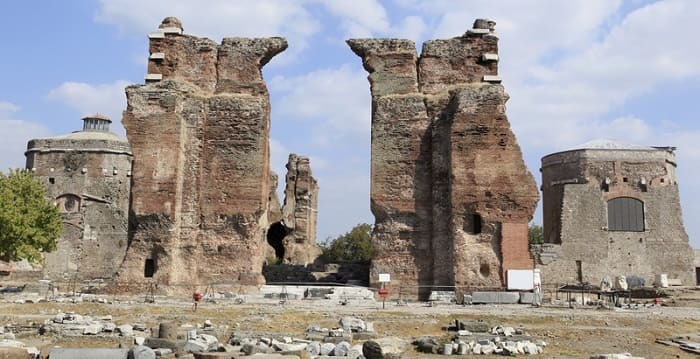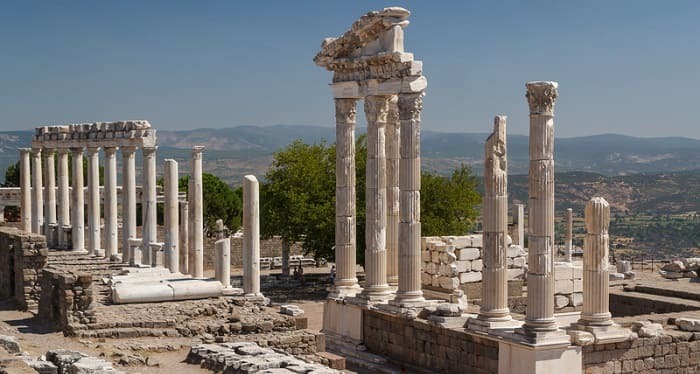

The Attalid dynasty was an influential Hellenistic kingdom that ruled the city of Pergamon from 241 BC to 133 BC. During their rule, the city rose to become a major centre of culture, trade, and art in the ancient world. The Attalids were known for their impressive library, the great Temple of Zeus, and for their patronage of the arts and sciences.

Red Basilica in the Ancient Greek City of Pergamon
Philetaerus was an ambitious and enterprising leader who founded the Attalid Dynasty in 241 BCE. He was a general of the Seleucid Empire and served as treasurer under the rule of the Seleucid king Antiochus II. After the death of Antiochus II, Philetaerus declared himself king and established the Attalid Dynasty in Pergamon, located in modern-day Turkey.
Philetaerus was successful in unifying the cities of Asia Minor and creating a solid economy. He also constructed impressive monuments such as the Altar of Zeus, as well as founding the first library in the ancient world. His leadership enabled the Attalid Dynasty to reach its peak of prosperity and power.
The legacy of Philetaerus lives on today, as his successful reign is remembered as an example of strong leadership and accomplishments. He is credited with establishing the Attalid Dynasty and laying the foundation for a successful kingdom. His legacy serves as a reminder of the power and potential of strong leadership.
Attalus was the first ruler of the Attalid Dynasty, which he founded in 241 BCE. He was the son of Philetaerus, a general of the Seleucid Empire, and succeeded his father as king after his death. Under Attalus's rule, the Attalid Dynasty reached its peak of power and prosperity.
Attalus was a successful leader and was able to expand the kingdom's borders and establish a strong, unified kingdom. He also built impressive monuments. Additionally, he was able to maintain strong diplomatic relationships with neighbouring states, which enabled the kingdom to grow and flourish.
Attalus is remembered for his strong leadership and accomplishments. He is credited with establishing the Attalid Dynasty and laying the foundation for a prosperous kingdom. His legacy lives on today as a symbol of power and success.
The Attalid Dynasty had strong relations with Rome during its reign, which lasted from 241 BCE to 133 BCE. The Attalids were loyal allies of Rome and provided military aid to the Roman Republic in its wars with the Seleucid Empire. In return, the Romans provided financial and military aid to the Attalids, which enabled them to expand their kingdom and increase their power.
The Attalids also formed an alliance with Rome in order to protect Pergamon from the threat of the Galatians. This alliance ultimately led to the Roman annexation of Pergamon and the Attalid Dynasty in 133 BCE.
The Attalids and Rome had a mutually beneficial relationship throughout the Attalid Dynasty's reign. The Attalids were loyal allies of Rome and provided them with military aid, while Rome provided the Attalids with financial and military assistance. This relationship enabled both nations to become powerful and prosperous.
Pergamon flourished under the rule of the Attalid Dynasty from 241 BCE to 133 BCE. During this period, the city became a major centre of culture and learning. The Attalids built impressive monuments, such as the altar of Zeus, which was one of the most famous monuments of the ancient world. They also founded the first library in the ancient world, which housed over 200,000 scrolls.
Pergamon became a bustling centre of commerce and trade under the Attalids. The city was known for its exports of metal and textiles, which were traded with neighbouring cities. Additionally, the Attalids established a strong economy and fostered a thriving culture.
The Attalids created a prosperous kingdom in Pergamon, which enabled the city to flourish during their reign. The Attalids' achievements in Pergamon have left a lasting legacy, as the city is still remembered as a major centre of culture and learning.

Ruins of the ancient city of Pergamon
The Attalid Dynasty was a powerful and influential Hellenistic dynasty that left a lasting mark on the ancient world. The Attalids were known for their strong leadership, military power, and cultural achievements. Under the Attalids, Pergamon flourished and became a major centre of culture and learning. The Attalids' accomplishments have left a lasting legacy, as their achievements in Pergamon and Asia Minor are still remembered today.
Q1. How is Pergamon mentioned in the Bible?
Ans. Pergamon is mentioned in the book of Revelation 2:12-17. In this passage, Jesus speaks to the church at Pergamum and gives them a stern warning that they are in danger of following false teachings. He warns them to be faithful to the truth or face His judgment.
Q2. How was the Pergamon destroyed?
Ans. The city of Pergamon was destroyed in 263 AD during the Roman invasion of the Roman province of Asia. During the siege, the city was set on fire and much of the city was destroyed. The ruins of Pergamon remain today, a testament to its former grandeur and power.
Q3. Who was the last ruler of the Attalid dynasty?
Ans. The last ruler of the Attalid dynasty was Attalus III, who died without an heir in 133 BC. The kingdom was inherited by the Roman Republic, marking the end of the Attalid dynasty.